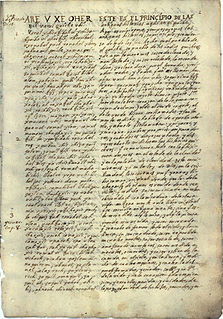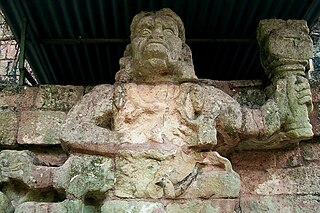Related Research Articles
Maya mythology is part of Mesoamerican mythology and comprises all of the Maya tales in which personified forces of nature, deities, and the heroes interacting with these play the main roles. The myths of the Pre-Hispanic era have to be reconstructed from iconography. Other parts of Mayan like oral tradition are not considered here.

Qʼuqʼumatz was a deity of the Postclassic Kʼicheʼ Maya. Qʼuqʼumatz was the Feathered Serpent divinity of the Popol Vuh who created humanity together with the god Tepeu. Qʼuqʼumatz is considered to be the rough equivalent of the Aztec god Quetzalcoatl, and also of Kukulkan of the Yucatec Maya tradition. It is likely that the feathered serpent deity was borrowed from one of these two peoples and blended with other deities to provide the god Qʼuqʼumatz that the Kʼicheʼ worshipped. Qʼuqʼumatz may have had his origin in the Valley of Mexico; some scholars have equated the deity with the Aztec deity Ehecatl-Quetzalcoatl, who was also a creator god. Qʼuqʼumatz may originally have been the same god as Tohil, the Kʼicheʼ sun god who also had attributes of the feathered serpent, but they later diverged and each deity came to have a separate priesthood.

Huracan, often referred to as U Kʼux Kaj, the "Heart of Sky", is a Kʼicheʼ Maya god of wind, storm, fire and one of the creator deities who participated in all three attempts at creating humanity. He also caused the Great Flood after the second generation of humans angered the gods. He supposedly lived in the windy mists above the floodwaters and repeatedly invoked "earth" until land came up from the seas.

Xibalba, roughly translated as "place of fear", is the name of the underworld in Maya mythology, ruled by the Maya death gods and their helpers. In 16th-century Verapaz, the entrance to Xibalba was traditionally held to be a cave in the vicinity of Cobán, Guatemala. Cave systems in nearby Belize have also been referred to as the entrance to Xibalba. In some Maya areas, the Milky Way is viewed as the road to Xibalba.

In Maya mythology, Camazotz was a bat god. Camazotz means "death bat" in the Kʼicheʼ language. In Mesoamerica the bat was associated with night, death, and sacrifice.

Popol Vuh is a text recounting the mythology and history of the Kʼicheʼ people, one of the Maya peoples, who inhabit the Guatemalan Highlands northwest of present-day Guatemala City.
Kʼicheʼ are indigenous peoples of the Americas and are one of the Maya peoples. The Kʼicheʼ language is a Mesoamerican language in the Mayan language family. The highland Kʼicheʼ states in the pre-Columbian era are associated with the ancient Maya civilization, and reached the peak of their power and influence during the Mayan Postclassic period. The meaning of the word Kʼicheʼ is "many trees". The Nahuatl translation, Cuauhtēmallān "Place of the Many Trees (People)", is the origin of the word Guatemala. Quiché Department is also named for them. Rigoberta Menchú, an activist for indigenous rights who won the Nobel Peace Prize in 1992, is perhaps the best-known Kʼicheʼ.

Tecun Uman was one of the last rulers of the K'iche' Maya people, in the Highlands of what is now Guatemala. According to the Kaqchikel annals, he was slain by Spanish conquistador Pedro de Alvarado while waging battle against the Spanish and their allies on the approach to Quetzaltenango on 12 February 1524. Tecun Uman was declared Guatemala's official national hero on March 22, 1960 and is commemorated on February 20, the popular anniversary of his death. Tecun Uman has inspired a wide variety of activities ranging from the production of statues and poetry to the retelling of the legend in the form of folkloric dances to prayers. Despite this, Tecun Uman's existence is not well documented, and it has proven to be difficult to separate the man from the legend.
Tollan, Tolan, or Tolán is a name used for the capital cities of two empires of Pre-Columbian Mesoamerica; first for Teotihuacan, and later for the Toltec capital, Tula, both in Mexico. The name has also been applied to the Postclassic Mexican settlement Cholula.
Xquic is a mythological figure known from the 16th century Kʼicheʼ manuscript Popol Vuh. She was the daughter of one of the lords of Xibalba, called Cuchumaquic, Xibalba being the Maya underworld. Noted particularly for being the mother of the Maya Hero Twins, Hunahpu and Xbalanque, she is sometimes considered to be the Maya goddess associated with the waning moon. However, there is no evidence for this in the Popol Vuh text itself.
Vucub-Caquix is the name of a bird demon defeated by the Hero Twins of a Kʼicheʼ-Mayan myth preserved in an 18th-century document, entitled ʼPopol Vuhʼ. The episode of the demon's defeat was already known in the Late Preclassic Period, before the year 200 AD. He was also the father of Zipacna, an underworld demon deity, and Cabrakan, the Earthquake God.

Among the Classic Mayas, the howler monkey god was a major deity of the arts—including music—and a patron of the artisans, especially of the scribes and sculptors. As such, his sphere of influence overlapped with that of the Tonsured Maize God. The monkey patrons—there are often two of them—have been depicted on Classic vases in the act of writing books and carving human heads. Together, these two activities may have constituted a metaphor for the creation of mankind, with the book containing the birth signs and the head the life principle or 'soul', an interpretation reinforced by the craftsman titles of the creator gods in the Popol Vuh.
Classical Kʼicheʼ was an ancestral form of the modern-day Kʼicheʼ language, which was spoken in the highland regions of Guatemala around the time of the 16th century Spanish conquest of Guatemala. Classical Quiché has been preserved in a number of historical Mesoamerican documents, lineage histories, missionary texts and dictionaries, and is the language in which the renowned highland Maya creation account Popol Vuh is written.

The Feathered Serpent was a prominent supernatural entity or deity, found in many Mesoamerican religions. It is still called Quetzalcoatl among the Aztecs, Kukulkan among the Yucatec Maya, and Q'uq'umatz and Tohil among the K'iche' Maya. The real translation is "Precious Holy Snake" or "Precious Holy Twin" with no evidence of this character having a beard or being European as new age people misinterpreted as the "Jesus of the Americas".
The Baile de la Conquista or Dance of the Conquest is a traditional folkloric dance from Guatemala. The dance reenacts the invasion led by Spanish conquistador Pedro de Alvarado and his confrontation with Tecun Uman, ruler of K'iche' kingdom of Q'umarkaj. Although the dance is more closely associated with Guatemalan traditions, it has been performed in early colonial regions of Latin America at the urging of Catholic friars and priests, as a method of converting various native populations and African slaves to the Catholic Church.
Various sorts of dogs are known to have existed in prehispanic Mesoamerica, as shown by archaeological and iconographical sources, and the testimonies of the 16th-century Spaniards. In the Central Mexican area, there were three races: the medium-sized furred dog (itzcuintli), the medium-sized hairless dog (xoloitzcuintli), and the short-legged, (tlalchichi) based in Colima and now extinct. Apart from other, more obvious functions, dogs were also used for food and ritual sacrifice.
Andrés Xiloj Peruch was a K'iche' daykeeper from Momostenango in Guatemala. He was also one of the four "chuchkajawib" of Momostenango. After his death, his son Angél became chuchkajaw of the Santa Isabel lineage. Being a native speaker of the K'iche' language and a practitioner of traditional Maya calendric divination, he served as a consultant for several anthropological studies. He assisted Dennis Tedlock in elaborating his award-winning translation of the ancient K'iche' document Popol Vuh. Dennis Tedlock has described the translation process as "three-way dialogue among Andres Xiloj, the Popol Vuh text, and myself."
The Maya death gods, known by a variety of names, are two basic types of death gods who are respectively represented by the 16th-century Yucatec deities Hunhau and Uacmitun Ahau mentioned by Spanish Bishop Landa. Hunhau is the lord of the Underworld. Iconographically, Hunhau and Uacmitun Ahau correspond to the Gods A and A'.
A large number of Mesoamerican flood myths have been documented in written form or passed down through in oral tradition. Some clearly have Christian influences, but others are believed by scholars to represent native flood myths of pre-Columbian origin.

The Título de Totonicapán, sometimes referred to as the Título de los Señores de Totonicapán is the name given to a Kʼicheʼ language document written around 1554 in Guatemala. The Título de Totonicapán is one of the two most important surviving colonial period Kʼicheʼ language documents, together with the Popol Vuh. The document contains history and legend of the Kʼicheʼ people from their mythical origins down to the reign of their most powerful king, Kʼiqʼab.
References
- ↑ Preuss, Mary H. (1988). Gods of the Popol Vuh: Xmucane', K'ucumatz, Tojil, and Jurakan. Culver City, CA: Labyrinthos. ISBN 0-911437-25-8. OCLC 18646724.
- ↑ Tedlock, Dennis (Ed. and trans.) (1985). Popol Vuh: The Definitive Edition of the Maya Book of the Dawn of Life and the Glories of Gods and Kings. New York: Simon & Schuster. ISBN 0-671-45241-X. OCLC 11467786.
- ↑ Popol Vuh: The Book of the People: Popol Vuh: Preamble Archived 2007-10-17 at the Wayback Machine
| This article relating to a myth or legend from Mesoamerica is a stub. You can help Wikipedia by expanding it. |